This will probably be the last post from this blog (except for a short ‘I told you so’ in November, when Fonzie throws in a new excuse).
In fact, I wasn’t going to publish anything again, because I thought I had already made my point. But since an important website picked up the news, I’m going to present one last theory. A more global explanation (more “holistic”, if you will) for the inexplicable.
TL;DR Determined to make the game with the best graphics for Genesis/MD, Gwénaël Godde takes a shortcut using different hardware than planned. Trying to retrofit it proves unsuccessful. The project went dormant until he launched a hype campaign to raise funds to achieve this goal. Of course this only increased the problems.
Disclaimer: I’m not trying to convince anyone. People have already taken sides for or against WM. When they say that this blog is a Fonzie marketing move, it’s disheartening. I recently learned that you can’t change the opinion of others, at least on the Internet. Read the following lines under your responsibility, and draw your own conclusions.
Project Y “Paprium” TIMELINE
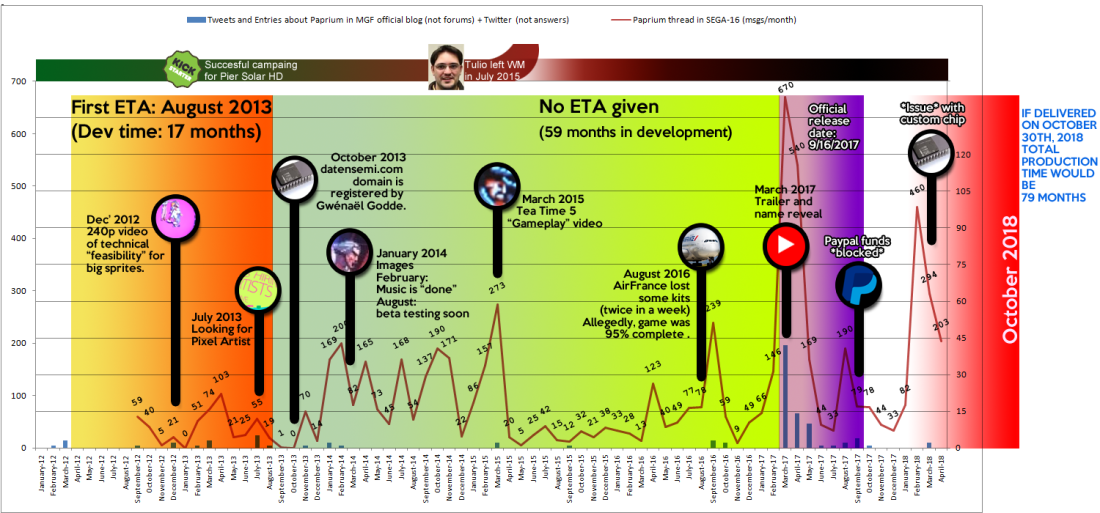
In this graphic, the blue vertical bars represent communications from WM. Basically, post on its official blog (https://www.magicalgamefactory.com) and its Twitter account (@watermelongames). I didn’t include Facebook, because many posts are shared between both social networks, and many elements have been deleted over the years.
The red continuous line represents the messages in the official thread for the game at sega-16.com (http://www.sega-16.com/forum/showthread.php?22142-Paprium-Official-Thread).
The colored areas are different phases that the game has gone through, usually between two completion dates.
The band above the chart is who was in charge of WM, with a green start, during the command of Tulio Cardoso Gonçalves, until a black end, for obvious reasons, with the reign of G.G. “Fonzie.”
In 75 months they spread 105 messages through their official channels. That’s a healthy 1.4 messages per month, loaded with ‘juicy’ information, technical details, game images, maybe a demo?
Well, not really… First, the quality of the information provided by the guys Watermelon was always laughable, to put it mildly. And second, it was never constant. They went through long periods of absolute radio silence. People were deliberately kept in the dark.
If you count the months with zero messages, it’s 52. Yeah, you read that right. 52 months without messages about the most important project for this company. 52 months in which they did not answer, report, or explain what was going on with the game to the (presumably) thousands of people who gave money to make the game happen.
And before anyone says, ‘oh, actually in month X, there was a post…’, go and count messages in their Twitter account (not replies), and on magicalgameFactory.com. Of course I don’t include what came up on Pier Solar or other projects. Of course I do not include what team members have expressed in various forums, as well as WM forums. That’s gossip. If you are a company, or a serious group, you want people to accept your information through formal channels (official accounts). Well, on those formal channels, the company, in a period of 75 months, has been silent for 52.
Regarding Paprium, for more than 4 years, Fonzie has had his lips sealed.
Let’s use a lighter format. Let’s pretend to be Snopes.com and ponder the truthfulness of some of the statements concerning Paprium and what WaterMelon was, in general. And let’s start with that last statement, if you will. I’m using three main sources: SEGA-16 forum, video of Luis Martins with St1ka, and the video of Tulio in Muscatine.
The number of months in which WM has not advanced information on this project totals almost 4.5 years.
TRUE – See explanation above.
Watermelon is a real company.
MIXED – Of course, Watermelon is a company incorporated in the state of Iowa, US in February 2009. BUT:
- WM has no offices. The office in Muscatine was closed some time later, after Tulio broke up the partnership. Godde’s current whereabouts are unknown.
- WM has no employees. WM has always worked in a distributed manner. People were hired ad-hoc, to perform specific tasks, and once their part was done, they were not presented with a new task. If at some point all the staff who worked on Pier Solar or Paprium had wanted to have that family picture of the company taken, you know, when all the employees get together on the same day and say “cheese”, people would have had to travel from all over the world. There’s nothing wrong with having staff in different parts of the globe. But, currently the company has no contracts with anyone. Although there is a game to be made, all involved claim that their tasks are complete. There’s nothing left to do. Art: done. Music: done. Programming: done. Except for some mythical workers in China, who have been described testing the game, making it, stockpiling it, testing it again, at different times, sometimes in reverse order.
- WM has a meager source of income. For a company that bases its sales on hype (not a criticism, they sell cultural products that lose their appeal after a while -just like movies or pop music), not having new stuff in the shed is harmful. The only source of income I can think of is selling digital copies of Pier Solar on Steam and GOG. But obviously the bulk of those sales have already occurred. Now all that’s left are the crumbs. WM is right now an empty husk, a broken egg shell. It was once a duo, who together with other people created a game. Now it’s a tax form in a bank in Iowa, and an elusive Frenchman who tweets “soon” from time to time.
Pier Solar is the only Watermelon game
TRUE – WM is a one-hit wonder. Pier Solar on Genesis is not a different experience from the more modern platforms. It’s the same game. Yes, graphics are better, yes, tweaks were made here and there, but it’s the same game. The creative forces did not spring up again, the stars did not line up so that WM could say, “Behold, our second game”. Their gunpowder got wet. They lost the rabbit’s foot. In ten years (fourteen if we count the prehistory of Tulio-Gwénaël, back in 2004), they could not come up with anything else. They never got past Tavern RPG.
Fonzie is a talented programmer

ok, here is when is put the ‘false’ rating, but I really don’t know. I will put a “doubt” instead of a “false”. I am almost certain that it is false, but I have no confirmation, only hints.
Doubt – Gwénaël Godde was known as Fonzie Voltnov, back in the day. Doesn’t sound very Gallic, does it? Maybe it’s her mom’s maiden name. The guy certainly has a Rasputin flair. By googling that name, a lot of information about Bigstache comes up, when he was making his first steps in the retro community. Besides a series of demos (most of which are available on http://www.genny4ever.net/index.php?page=works), we only know of one piece of software other than Pier Solar: Mighty Mighty Missile. And it’s not that good.
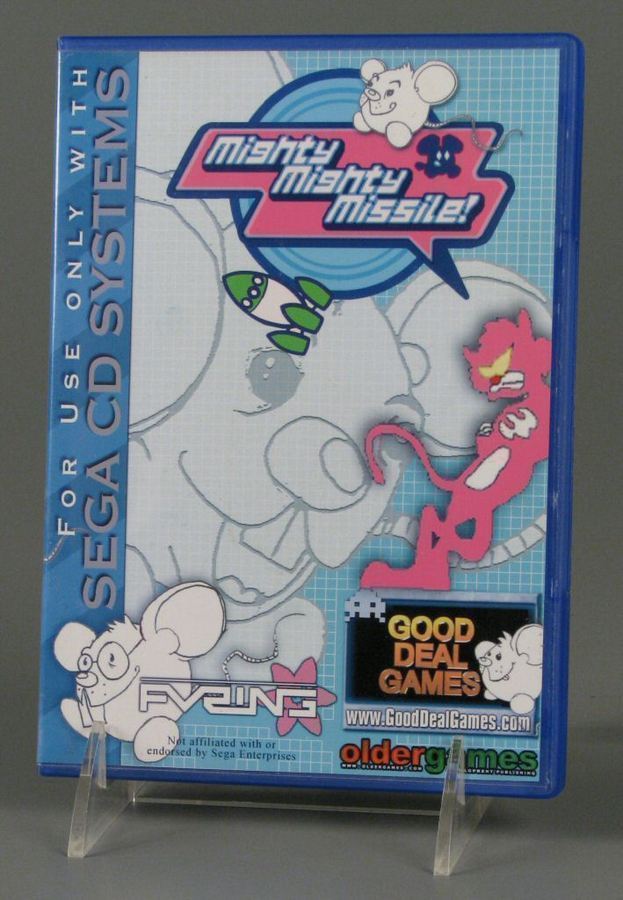
There’s a story behind this game. In Fonzie’s own words:
It is my first attempt to program a game for the Mega Drive/Mega CD, and of course, it is originally based on ChuChu Rocket. Due to some sound issues (Mega Drive sound tools were not available back in 2003), I decided to do a Mega CD release under a different name. A guy called Mask of Destiny did the Sega CD sound driver and I coded the whole game. Both were coded from scratch, and it was very challenging. Oldergames was going to publish the game, so we sent a beta of the game to make a show at Classic Gaming Expo 2004, and those guys decided to publish the beta instead of waiting for the final. It was a big, bad flop.
Then Good Deal Games decided to publish it again, the final version this time. I think there were more betas sold than final. Some bad reviews were written, which doomed the game. In my opinion, even if the sound can get glitchy (never happened in my copy), it is still a great tribute to Sega. (Editor’s note: Mask of Destiny is one of the first fans who did Mega CD coding. He used ASM loading and PCM routines and has made a sound engine for the system. He helped Fonzie with the Mighty Mighty Missile project and also a cartridge dump cable via the Mega CD, which is available for purchase at Fonzie’s website.)
Here we see Fonzie Voltnov pumping up his product:
Rest assured, he delivers:
Source: http://web.archive.org/web/20041012071519/http://fvring.free.digitartstudio.com:80/index.php?main=hom
At that time he was very active in the forum segaxtreme.net. He even opened a thread to beg another user to help him with the sound of Mighty Mighty Missile. Quite sad.
Checking fonzievoltnov profile is like finding an old slide on the street. A window to a time that has passed, a snapshot that is losing its colours. That was almost 15 years ago. And to be honest, I think that rookie version of Fonzie was better. When he tried to be part of the community, he would participate with demos, ask others for help without fear. He was naive, humble… Heck, old Fonzie would have proved me right:
Old Godde was good Godde. Except for the hate speech.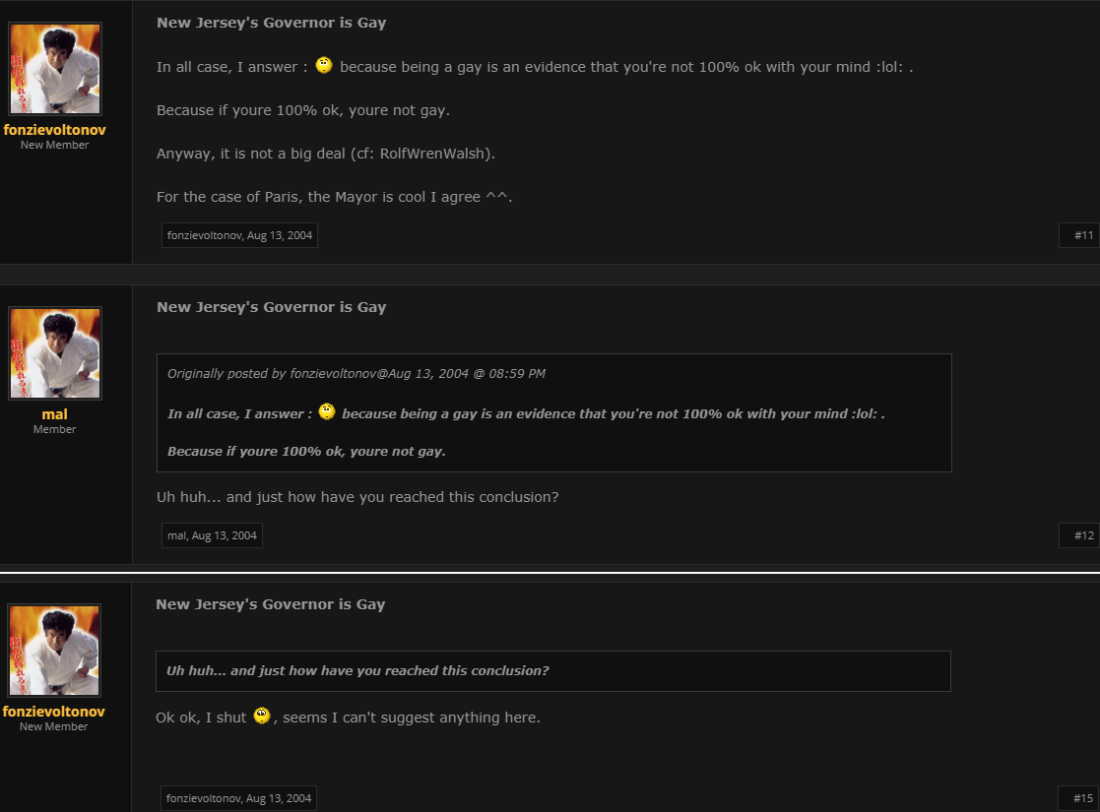
Fifteen years down the road, this guy knows every trick, he knows every atom of silicon in the VDP. Or at least that’s what people tell me. Let us suppose for a moment that it is so. What good has it done him? This Mozart of the assembler is seeing his effort to show the world his talent frustrated by: a) Baggage handlers who do their work badly b) Someone at Paypal c) a chip. It is not a multiple-choice test. It’s an enumeration, a list. That happened, according to Fonzie, in that order. And that keeps us from playing the best game for Sega Genesis/MD. I’m glad other talented programmers haven’t had to deal with AirFrance or Paypal service, nor have they relied on a custom chip to implement one of their games. John Carmack, Éric Chahi really dodged a bullet there.
I guess it’s like the saying goes, “if a tree falls in a forest and no one is around to hear it, does it make a sound?”. One would expect that age-long experience would yield more and better games. Nothing could be further from the truth. Both in number and quality, Gwénaël Godde’s production has decreased. And yes, I’m saying that Paprium has less quality than Pier Solar, because, for all practical purposes, Paprium doesn’t exist yet. Nobody has played it, ergo its quality is zero or nil (it is not a judgment or criticism, if something does not have a tangible reality it cannot be qualified or evaluated in its quality. One can infer and hope that something is good, but that has more to do with faith.)
Fonzie may be a competent programmer. His history reflects a guy who started out wanting to conquer the world, and is now sinking with the Titanic, which he designed himself. He went from putting his products in people’s hands, when he was 19, to avoiding, lying and defrauding that same people. Remember that his last product was Pier Solar (2010). For the last eight years, Fonzie has been “non-producing”, “non-programming”. Last six years (a fucking fifth of his life) dedicated to a product that doesn’t fully take hold. In a fraction of that time new projects have arrived. People with more, same and less talent than him have managed to get games out in a matter of two or three semesters, not twelve (and counting).
Watermelon Games “GEMS” system was a total mess
TRUE – Apparently this was Tulio’s idea [UPDATE: Tulio claims it wasn’t his idea] . Gems are (were) a way to exchange your money for WM products. At first I thought that this convoluted system was simply a protection against fraud accusations . This is very common in multi-level scams, especially those involving tokens. But then I realized it was just a marketing strategy that didn’t work, and eventually ended up hurting the company. Let’s see why.
Gems are tokens (or credits). These credits have two functions. One, to acquire the WM games. Second is to influence the design of such games. Tulio has explained that WM was different from other indie developer groups in that they hear feedback from players. Customers have voting power over artistic decisions during game creation. Or that was the pitch.
While the motto that “we do this because we love to make retro games, not for money” is almost universal in the retro community, the facts show that the pursuit of profit drives a lot of choices when it comes to creating games. I’m not judging that. I want to emphasize that money is essential for a campaign of this kind (launching a game in physical format). Interfering with the cash flow can be lethal. And Tulio and Gwénaël did exactly that.
Simply put, the idea was that customers, excited at the prospect of their ideas being heard, would buy thousands of gems. As more gems were more votes, someone with deep pockets could (if that was his or her intention), basically, get a tailor-made game. Of course, with thousands of player-customers, the chances of someone doing that get a little thinner. Even so, Tulio declared that he “could see” people buying more and more gems, as they noticed that the election was taking a direction they didn’t like.
Now, that sounds interesting, doesn’t it? Here’s why it didn’t work out:
- Complete misunderstanding of their user base. In a way, people who buy games for retro platforms are the ideal customer. These are fairly accommodating buyers (because they don’t see themselves as buyers). It may sound blunt, but people are willing to buy anything as long as it has gold fingers. So, what is the need to involve people? Just make a good game and sell it. Someone will say, “Oh, but it’s nicer when customers participate”. Well, that may be true (although Steve Jobs and Alan Kay would disagree). Which brings us to the next point.
- Watermelon Games was never about openness or involving its backers. Yes, I am openly contradicting its founders. The facts back me up. Let’s remember that Pier Solar started as an RPG where the main characters would be members of the homebrew website Eidolon’s Inn. At some point that changed, and the game became your run-of-the-mill RPG.

Only self-centered Fonzie got a character with his face They took a unique idea, twisted it into something already rehashed a thousand times before, and made a business around it. And people loved it.
The way they kept their clients from getting relevant information is simply insane.
And the steps they took to make sure the game wasn’t pirated are ridiculous. If such was their commitment to customers, “crowd-designing” and openness, they should not only distribute the ROM on the internet for free, but also the source code. And finally, if you want people to participate so much, don’t charge for it. Involving people in the early stages of Paprium’s design was simply a marketing gimmick. - People don’t like to vote. They don’t want to be part of the creative process. It’s a very big burden. Again, a lack of understanding of their buyers’ psychology. Of course, you’ll always have that guy who wants to have an opinion on everything, and in the case of WM customers even more, because many are developers themselves. But you can take care of these people without charging them for it, and present the finished game to regular buyers. Choices should be limited to cartridge color, language options, packaging materials, or even the name of the game (a choice that was not allowed; today many people consider it a lousy name).
- The system was poorly explained. People didn’t understand what the gems were. Most people bought what they needed to get the game, and that was the end of their interaction with WM. They sat in their gems waiting for the game. Many people did not understand, or did not care that their gems resulted in voting power. Or they voted and whatever the outcome, they were happy, because they just wanted the damn game.
WM staff made no effort to educate their customers on these possibilities, so the system never worked as intended.
For a typical reaction of the average customer to the “gems” system, listen to this podcast (around minute 21:00). - There is a risk of underfunding. Your funding goal is development cost. But if you divide that by the number of copies you owe your investors, you just made a presale. Other rewards, especially intangible ones, are usually added to help people give out more money than is strictly necessary to get copies. That way fewer people give more money, while it is compensated with exclusive rewards, which separate them from those who buy the game in presales, or when it goes on sale. And I just described crowdfunding.
The folks at WM added another layer (thinking they were ingenious). They expected from every customer, not just the $50 a copy, but to buy more gems to secure some exclusive rewards, and also (here comes Fonzie and Tulio’s innovation) to buy gems to influence voting. It was the final stage of skimming customers. They made a website just for that (magicalgamefactory.com of course).
They imagined that people, just for the sake of being right, just to see one idea come to fruition, would dump thousands of gems, seeking to outbid other people. It was an auction of game features. Only that to people (desperate as they are to put a cartridge in their Sega console) any feature was fine. There was no real incentive to pour gems beyond the copies.
If the total they needed included the “auctioning of features” monies, and that fails, or is less successful than expected, your funding failed. Because of the way they handled it, I don’t think it was successful.
If it was a way to fleece their customers, and they were just being greedy, well, then the system could have had some use.
- They didn’t taste their own medicine. They used Kickstarter to fund Pier Solar HD. I guess the extra advertising and exposure that KS gives was worth that 5% of over a quarter of a million dollars.
If Kickstarter advertising was so important, why didn’t they use it for other projects (they could have run a campaign for Project Y/Paprium and no one would have batted an eyelash. Let us remember that not a year had passed since the project was launched).
If the gems system was so successful, why give thousands of dollars to a crowdfunding platform when you already have one (kinda).
- It’s fishy. Tokens are widely used in online scams, especially in pyramids or multi-level scams. By turning users’ money into tokens, the fraudster has already fulfilled his duty by giving them a “product”. The “purchase” is already done. They bought something, because the fraudster convinced them that it was “necessary” to do it that way. What he really wanted was money for nothing. Your money well earned in exchange for a token that today can give you what you crave, and tomorrow can be “degraded” to be worth almost nothing, leaving you empty-handed.
At first I thought that was the use of Fonzie’s gems. But then I realized it wasn’t the case. WM never altered the price of the gems (10 gems, one dollar). And they had a more than erratic path with purchase “windows” (further confusing people); a con man would have kept selling gems as long as he could.
They ran out of money
MIXED – I don’t think they hit rock bottom, but at first they were desperate for cash. I think they were really counting on the pay-for-voting thing. Because otherwise, there’s no explaining why they were selling a horrible poster for $120.

A British artist created a poster for the 20th anniversary of the MD. It was pretty simple. The limited edition of 100 copies sold for £30 ($48 at the time). Someone here is trying to justify the existence of such a piece of paper. 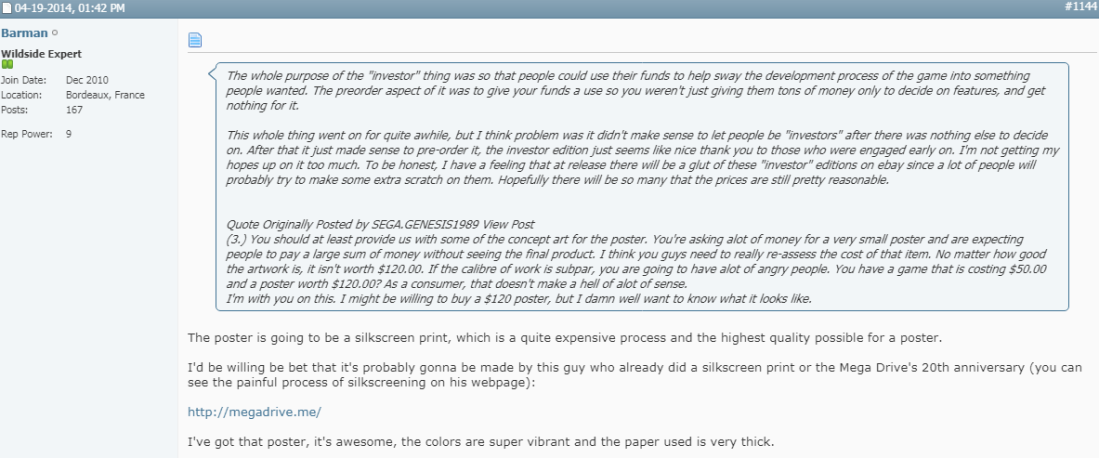 Fonzie thought he could almost triple the price. That’s crazy!
Fonzie thought he could almost triple the price. That’s crazy!
Paprium’s art director, Luis, said he was surprised by the high prices and promised to seek an alternative.
However they continued to promote the poster for over a year, as seen in this forum post from magicalgamefactory.com: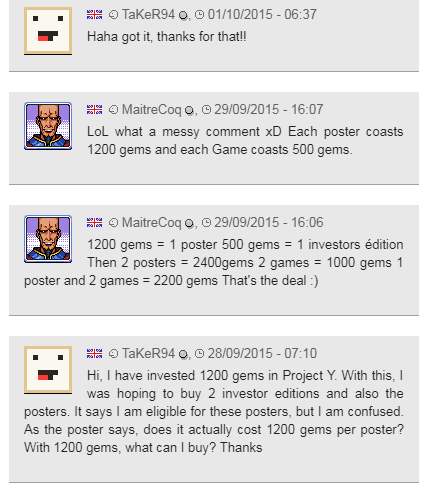
But people did not take the bait, because they were forced to come up with something more substantial for their customers.
 What was that fiasco? Why are three posters worth more than a PS4? What were they thinking?!
What was that fiasco? Why are three posters worth more than a PS4? What were they thinking?!
They sold (or intended to sell) something that must cost $6 to manufacture for 20 times its value. They were sucking money from wherever they could.
In a 2014 interview, Tulio stated that there were 3,000 users registered with MagicalGameFactory [source in Portuguese].
Let’s assume that all users understood the GEMS system and invested enough to get a copy of the game. That’s $150,000. Let’s remember that Paprium wasn’t the only project that was funded by the system, there was that N project. So arbitrarily, let’s say that of those 3k users, two-thirds invested in Paprium. $100,000 to fund the game.
Not bad. That’s more than Xeno Crisis got in Kickstarter ($90,000). It is a project of similar complexity, in which very talented artists are involved.
So $260,000 for Pier Solar HD, between $150,000 and $100,000 for Paprium, this indie studio had $400,000 at its disposal, and yet they tried to steal from its users with some painted sheets of paper.
Or maybe Tulio was misrepresenting the numbers of users (I don’t see why, 3000 is compatible with Pier Solar cartridges runs; it is reasonable to assume that most of the buyers were the first to subscribe to the MGF platform). Or even worse, that many users didn’t even invest $50 in the game. I think I already proved that the system was actually hurting the company.
I suspect the funding for Paprium was actually much less. Tulio made it his mission to take care of the proper use and spending of Kickstarter’s funds, and Fonzie had to deal with projects that were slowly approaching deadlines, with a funding system that was ill-conceived. A better reading of the situation, and less stubbornness in making decisions, would possibly have led to shutting down the inefficient MGF and turning to KS again.
When they unveiled the trailer, there was a second “funding round”. Hype was very strong, and Fonzie made the most of it economically. In fact, the only purpose of running a hype campaign was to get fresh funds, and buy more time, by making the public believe that the launch was imminent. Last-minute “delays” take effect because people are still mindful of the trailer, and keep an eye on the game.
It is my conviction that the game was “completed” (or something very much like a playable game was put together) in 2014.
Trailer went viral. And the cash started flowing into Fonzie’s accounts. Let’s do the math. I know I’m pulling these numbers out of my ass, but it serves as a basis for knowing how much money vanished by making this vaporware.
166k views in the first month, minus 3k users who had already purchased: 163k potential customers. Using a typical video advertising conversion rate (1.38%) we have about 2250 new customers. For convenience, let’s just say the trailer’s effort paid off in two thousand orders. That’s $138,000 (the price of a copy changed from $50 with the GEMS system to $69, shipping included, during presale).
Does that sound like a lot? Your trailer was seen in the last year by almost 300,000 people. If you managed to convince 1304 people (0.43%) to reserve a copy for $69, you will have $90,000: same amount as Xeno Crisis.
By this I mean that Paprium began his life with a dubious, complicated and inefficient financing scheme. Its creators used questionable tactics to try to reach their goal. And yet the game (or something very similar) was ready within two years (spring 2012 to summer 2014). Then, faced with the reality that the game was impossible to retrofit into the target console (Sega Genesis), excuses were given, or simply nothing was communicated (see the graph at the beginning of the “valley of silence” between March 2014 and March 2016). Then the decision was made to double the efforts. One last attempt to capture the public’s attention, get more funds, and finally run the game on the console. I think Fonzie believed that a hardware solution could be developed, and he needed fresh funds for that. Of course the campaign was based on false advertising, false information, strategies that Mr. Godde often uses. The new funds (money from 2012~2014 gems was used up a long time ago) are used to test whether it is possible to have a special cartridge that will allow the game to run as seen in the trailer, and at the same time (important point) to meet the refund requests. So, by saying, “If you don’t trust me, ask for your refund without any problems” you can reassure your customers, and keep the appearance of reliability, that the company is still operational, and that the game is still in development. Let’s hope those funds reach October of this year, and are enough for a good lawyer.
Datenmeister DT128M16VA1LT chipset is fake
TRUE – I’ve talked about this in other posts. So I’ll be brief. It’s fake and it’s just a publicity stunt because:
- The company that makes it doesn’t exist. Daten Semiconductors would be the company in charge of manufacturing the chip.
Datensemi.com website is registered by Mr. Fonzie in 2013. Daten Semiconductors has no links to any other technology company, is not listed as a supplier to any company (including Watermelon Games), and has no affiliation with IPC (“The global trade association serving the printed board and electronics assembly industries, their customers and suppliers“).
Daten Semiconductors has no links to any other technology company, is not listed as a supplier to any company (including Watermelon Games), and has no affiliation with IPC (“The global trade association serving the printed board and electronics assembly industries, their customers and suppliers“).
ISO 9001 certification and RoHS logos appear on the homepage. The IPC logo also appears, although it is not the IPC member logo (the members’ logo includes the word “member”). This company is not a real company, is not a member of IPC, is not ISO 9001 certified, and is not a RoHS compliant manufacturer.
The site is written in Chinese in its entirety, with no English version ( uncommon for a company that may aspire to have customers all over the world). The content of the site has remained unchanged over the last five years (again, unusual for an “innovative” company).
The site was registered in October 2013, however, there is a banner with the text “gold supplier 2009”. There is also a copyright notice 2005-2012. So the company’s site is created years after the company started operations. Weird for a business like this.
DT128M16VA1LT: searching for this does not provide any results on mouser.com and similar sites. The part does not exist.
- Its function is so vague, it could do any task. It’s a perfect example of vaporware. Since its “existence” was announced it has been:
An audio codec chip
A mapping chip
A graphics acceleration chip, achieving more “parallax layers”
A data compression chip.
An anti-piracy device
RAM memory
Backup memory
All of the above. - Paprium’s music was intended for a regular cartridge. In this interview in April 2017 (in the middle of Fonzie’s hype effort), David Burton, Paprium composer, explains the process of creating the music. Although Fonzie explains there that the chip will provide extra audio channels, it is clear that the music strictly uses the YM2612 chip. Considering that the music was mostly completed in 2014, when no one knew about the existence of the’Datenmeister’, it makes sense:
We used a custom made tracker code named: Wavemelon, which Tiido created. He would then routinely ask for feedback regarding bugs and features we wanted implemented. Tiido’s tracker gave us the option to create custom instruments for the YM2612, (Genesis sound chip) so if we ever needed a certain sound, all we had to do was tweak away in the software until we got the sound we wanted. I included a demo track (which you can listen to below) which demonstrates a programmed TL tweak (Total Level, a volume setting that distorts sound) right at the beginning of the track. This helps create a more dynamic sound.
The YM2612 is a 4OP chip. This means that it has four Operators (labelled in the image below as 1-4). Each Operator can be used to add depth on any given channel of a track. And by combining various parameters such as feedback, for example, all kinds of amazing sounds can be created. In a nutshell, the Mega Drive was actually a pretty powerful synth device, but only with the right tools. Yuzo Koshiro, for example, had the tools to shape his own sounds which is why his FM soundtracks sounded so good.
The Wavemelon also includes virtual cutoff and resonance knobs which can be found on most real hardware synthesizers. These offer the ability to filter sound so it can be very crisp, sharp, or muffled. Many dance acts use this technique to create variation in repetitive patterns. And thanks to the Wavemelon, we can now do it on the Mega Drive.
- Fonzie has no in-depth knowledge of hardware. In his Tototek years he was in charge of the interface side, not pcb or component design. I wonder if he has any knowledge of VHDL. I think these lines from his former partner Tulio speak volumes.
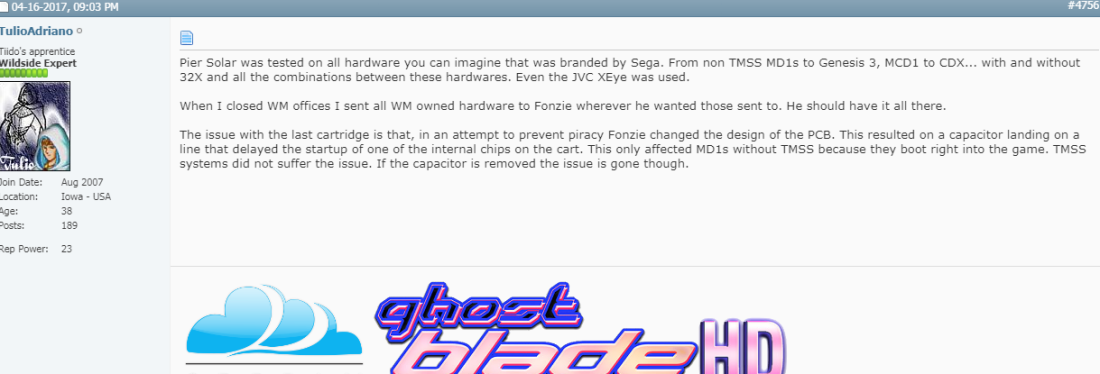
- It’s too expensive a solution. It would be totally unaffordable to use an ASIC chip or even an FPGA. Due to the volume of editions of this type (well under 10,000 units), a custom ASIC chip would be too expensive. FPGA may be more achievable, but the question is, why make the product more expensive, more complicated and delayed? But I can see Fonzie implementing an expensive solution that nobody asked for, while trying to recover money by selling posters, or leaving developers unpaid.
- Sound is Fonzie’s Achilles’ heel. Since its first commercial game, the sound implementation has been the nemesis of Mr Godde – why would this time be any different? He always ends up resorting to the kind charity of people who know more than he does.
- Fonzie kept Datemeister’s existence hidden until 2017. For four years no one knew that Paprium would make use of this powerful piece of silicon. Which makes you wonder what the fuck they were going to release in 2014 (if they met that deadline), or what the fuck is so great that it deserves to be almost 5 years late to come out.
- If it’s a rebranded ordinary chip, there’s no point in having implementation problems that they’ re having allegedly. Some forum users have justified the creation of a fake semiconductor factory, and basically the invention of an entire Datenmeister lore, as a marketing gimmick. They say Fonzie uses a standard chip, but since he’s a marketing genius, he designs a logo, a name, and people love it. It’s purple, and it has a German name! Cool! Well, I see two problems with this. What took him so long to show it? If it’s a marketing move, why did he wait four years to do it? And why are the chip problems only now being discovered? If you didn’t have to worry about the design of the chip, if it’s something tested and used in other applications, how does such an important component that is supposedly tested thoroughly since 2014 only give us problems at the last minute? And they were testing a cartridge in 2014. It’s part of their press kit.
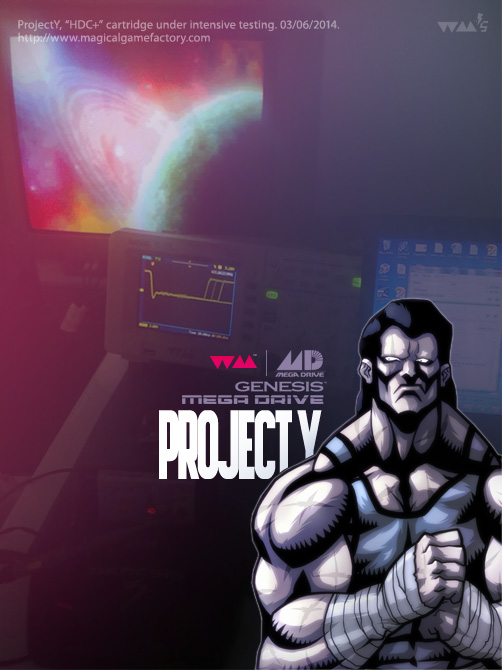
- It’s an excuse. As we know, Fonzie’s excuses have no correlation with reality. They’re lies to avoid taking responsibility. For whatever reason Fonzie created the legend of the Datenmeister (marketing, engineering gullibility, practicing Chinese), this chip provides invaluable services to him, having aborted the launch date of “early 2018”.
Gwenael Godde ‘Fonzie’ is solely to blame.
TRUE – As the only person with decision-making power in the company, he is the sole responsible. His track record of actions against employees, partners and customers, shows someone who thinks only of himself. Paprium was his idea, and he decided to turn it into something that can’t work. He took all the steps necessary to deny people the game they paid for. I believe that the collaborators closest to him know the truth, or suspect that there is no game. That all these years they’ve been trying to get to the end of the rainbow. Especially Luis Martins, who gave Paprium the cyberpunk look (which I consider remarkable). If Fonzie is Paprium’s dad, Luis is the mom. The guy still has images of Paprium as profile pic on Twitter. And he’s right to do so. In theory the project is still alive, and it is the project that most represents him. But he must also know, better than we do, because he was in WM’s “kitchen”, that there will be harsh months ahead. Months of silence and lies. So far Luis has been a valuable soldier to the cause. He was Paprium’s human face after Tulio left. And at times, he has been WM’s only link to the community. I think Fonzie has a reality distortion field. He persuades people, and puts people on his side, even if they are defending a lost cause. When Paprium’s thread at SEGA-16 stalled on a difficult subject (trailer transparency effects), Luis, the man who should have known why we were seeing what we were seeing, used a distraction to avoid the topic. 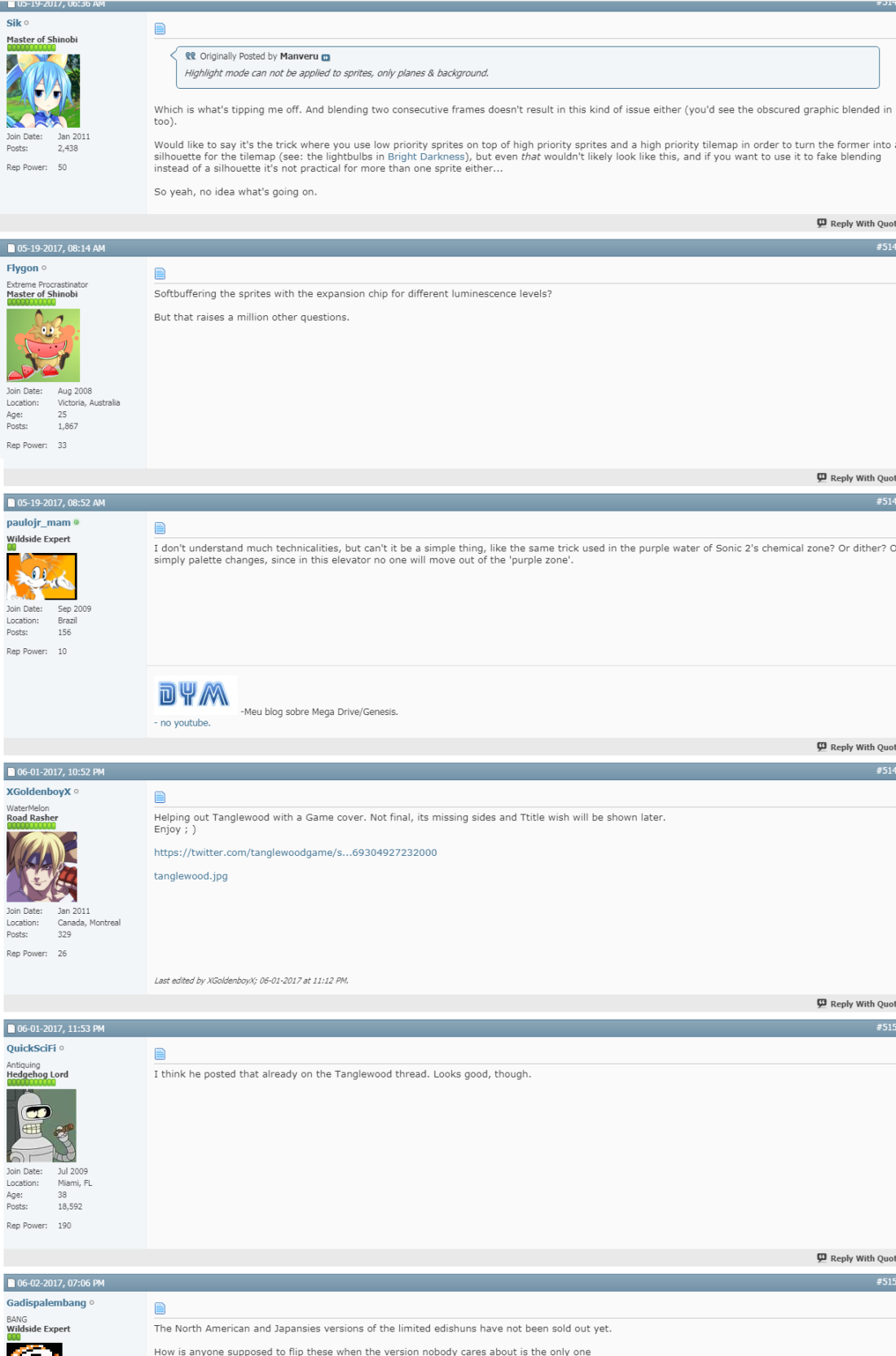
I’m not saying he behaved in a bad way. There is so much at stake for those closest to Fonzie that they cannot afford to see the project wrecked. None of this would have been necessary if Fonzie had done the right thing: not lying and keeping his patrons up to date. Some, like Zebbe, have abandoned ship. The guy you see sitting there is the same guy who edited the very first message from Paprium’s thread in SEGA-16 to describe the game as vaporware. 
Then there’s Tulio. He seems like a nice guy, and I think the success of Watermelon/Pier Solar bears his signature. He’s someone much more reasonable than Fonzie. In the Muscatine interview, he stated that he decided to leave WM in October or November 2014, but stayed until July 2015, to ensure that Pier Solar HD was finally completed. It was always strange to me that he left the company he founded, having barely achieved one of his goals (to port Pier Solar to modern systems). Left a job to dedicate himself to WM full time, went through a successful crowdfunding campaign, and one day step aside. To start over. Disagreements with Fonzie happened because the Frenchman refused to port projects to modern consoles.But there has to be something else. Something to scare away the good Tulio, to the point where he prefers to give up everything he had achieved to keep his hands clean.
I think it was (it’s a theory, I have no proof), that Tulio discovered the true nature of Project Y. He found out how far Fonzie could go. He learned that what would keep the company afloat for years to come was basically a fraud. Tulio then left the company, giving the benefit of the doubt to his former partner. He didn’t want to make him his enemy, and after all, it was Fonzie’s project.
In conclusion
Watermelon Games is now over. Project Y/Paprium would have been developed for a more powerful platform than SEGA Genesis. This decision was motivated by Fonzie’s ambitions to be the creator of the best 16-bit game. He acted alone, and prevented his collaborators from being exposed to the truth.
His strategy of silence or misinformation is eroding the reputation that WM had achieved with Pier Solar.
When the day comes when Fonzie admits he can’t deliver the game, or delivers a much inferior version than promised, he will have broken ties with very talented collaborators, who believed in him, and will have the rejection of the people he betrayed.
I believe that real efforts were made to bring the game to market between 2013 and 2014. As a result of this work, the game got its graphic art, and music. It is possible that the complexity of the game, and Fonzie’s interest in preserving the graphic splendor achieved by the pixel artists, caused him to use some shortcuts. He may have used libraries for Neo Geo instead of Sega Genesis.
He could also have programmed the game for PC. Transparency effects can result from video editing. This would constitute false advertising.
The pictures released in 2014 do not differ much from the trailer footage. The shortage of images or video gameplay does not allow you to assess how many levels were created, or the actual scale of the game. The game made no obvious progress between 2014 and 2017~2018, which is in line with the theory that the development of the game stopped in 2014, and since then Fonzie has been looking for a way to (really) implement it on Sega Genesis. Fonzie believes (or believed) that a hardware solution is possible, with a “magic” chip in the cartridge. The 2017 release of the game would have been to raise funds to develop such a solution (not Fonzie in person, but outside talent). Fonzie also knows that if that’s not possible, the game (and WM) has no future. He gave himself until October of this year, and said it is “the last chance”.
For all that, I have no hope that the game will come out in October, nor ever. All that remains is to wait a few months. Probably Fonzie will give another excuse. We’ll see how many he persuades.
My sources are
Paprium: Official Thread
Tulio Goncalves, 2Dream video game developers @Startup Grind Muscatine
St1ka’s Retro Corner Live Stream: Mega Drive (Feat. Paprium Art Director, Luis Martins)
Follow me on Twitter
@paprium_fiasco
Paprium looks good. It was definitely worth the wait. Even on my android. The colors sing. Hopefully you will make new posts. Thanks papriumfiasco
LikeLike
God, I hope you’re wrong, but sadly, you’re probably right.
LikeLike
So true…im sad
LikeLike
Is it possible the release party was a trick to try and get PayPal to release more funds? Basically to try and trick PayPal into believing the game was finished? Just a thought. I have no interest in the game but watching this train wreck is pretty entertaining. These people have no business running a company.
LikeLike